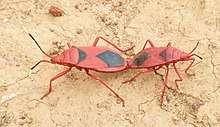Probergrothius sanguinolens
Probergrothius sanguinolens is a bug found in India. They feed on a range of seeds and are particularly common on the seeds of Sterculia and other Malvaceae. They also feed on freshly dead animal matter with early instar nymphs preferring to animal matter to seeds.[2]
| Probergrothius sanguinolens | |
|---|---|
 | |
| Mating pair from Bangalore | |
| Scientific classification | |
| Kingdom: | Animalia |
| Phylum: | Arthropoda |
| Class: | Insecta |
| Order: | Hemiptera |
| Family: | Pyrrhocoridae |
| Genus: | Probergrothius |
| Species: | P. sanguinolens |
| Binomial name | |
| Probergrothius sanguinolens (Amyot and Serville, 1843)[1] | |
| Synonyms | |
|
Odontopus sanguinolens | |
The adult bug is predominantly red. The second antennal segment is slightly longer than the first. The second and third antennal segments, the scutellum, all or part of the clavus, and wing membrane are black. The fourth segment of the antenna is creamy white and its tip is dusky.[3]
Bacteria in the genus Gordonibacter are known to be gut microsymbionts and a phylogenetic study of mitochondrial gene sequences suggests that the genus Probergrothius split from the common ancestors of Dysdercus, Dindymus, Scanthius, and Pyrrhocoris around 86.5±23 mya.[4]
References
- Amyot, C-J-B.; Serville, Audinet (1843). Histoire Naturelle des Insectes. Hemipteres. Volume 8. Paris: Librairie Encyclopedique de Roret. p. 271.
- Gurusubramanian, G.; Prakash, D.S.; Jeyakumar, A. (1996). "Chemical ecology of Probergrothius sanguinolens (Hempitera: Pyrrhocoridae) in relation to herbivory and carnivory" (PDF). Proc. Indian Natl. Sci. Acad. B. 62 (2): 81–90.
- Distant, W.L. (1904). The Fauna of British India, including Ceylon and Burma. Rhynchota. Volume II (Heteroptera). London: Taylor and Francis. p. 110.
- Sudakaran, Sailendharan; Retz, Franziska; Kikuchi, Yoshitomo; Kost, Christian; Kaltenpoth, Martin (2015-05-29). "Evolutionary transition in symbiotic syndromes enabled diversification of phytophagous insects on an imbalanced diet". The ISME Journal. 9 (12): 2587–2604. doi:10.1038/ismej.2015.75. ISSN 1751-7362. PMC 4817627. PMID 26023876.